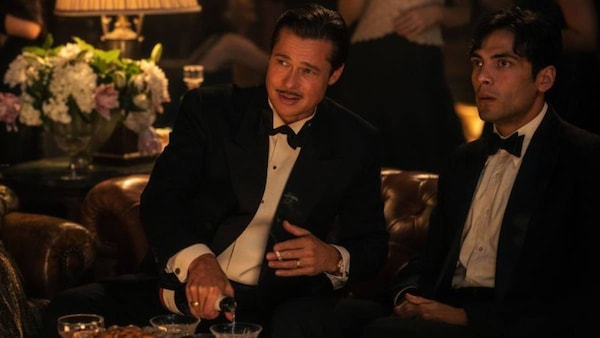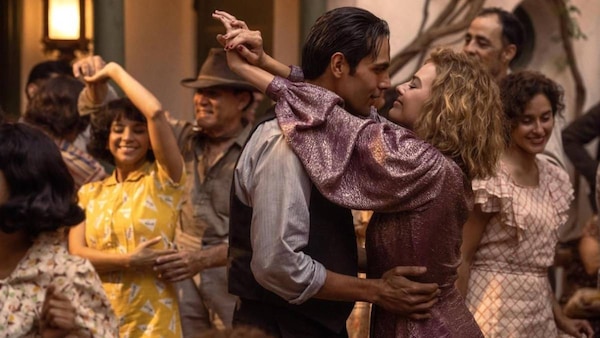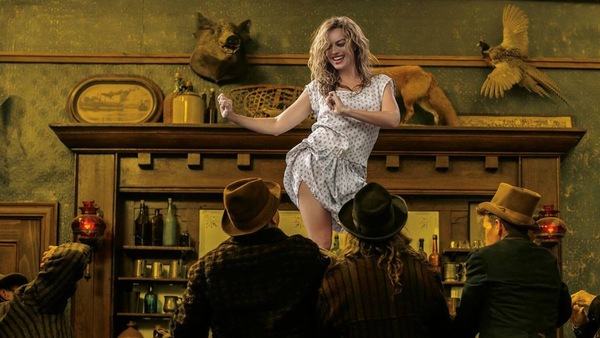Newsletter | With Babylon, Tinseltown’s Creation Myth Gets A Second Draft
Babylon is a feverish take on the Roaring Twenties punctuated not with an unconditional full-stop, but with a series of exclamation points and the odd question mark in between. Prahlad Srihari writes.

Last Updated: 02.24 PM, May 05, 2023
This column was originally published as part of our newsletter The Daily Show on April 6, 2023. Subscribe here. (We're awesome about not spamming your inbox!)
***
HOLLYWOOD in the 1920s, as distilled to its essence of outrageous excess by Damien Chazelle in Babylon, feels more like a natural extension of Caligula’s Rome. An orgy befitting the end of the world gets the party rolling. We’re talking mountains of cocaine, fountains of gin and champagne, revellers getting piss drunk and pissed on, shitfaced and shat on, naked to half-naked bodies writhing wall-to-wall and gyrating against each other, and a dwarf riding a giant dildo like a pogo stick. The bacchanal lives, breathes and dances to the staggered pulse of heady jazz. Just watching the camera survey the decadence is enough to get a contact high, if not whiplash. We get a sense of a filmmaker himself intoxicated on the frenetic ecstasy of filmmaking.
Crashing the party, quite literally in a car, is Nellie LaRoy (Margot Robbie), a young woman from Jersey whose dramatic entrance matches her outsized Hollywood ambitions. Snorting a mound of cocaine by herself, she hits the dance floor in her red dress with a plunging neckline, her tousled hair waving back and forth, catching the eye of a casting director itching to find a replacement for a young actress who has OD’d at the same party. Funny how life works, as they say. The very next morning, Nellie finds herself on the set of a movie showing off her acting range in a performance that prompts gossip columnist Elinor St John (Jean Smart) to declare: “Never have I seen such a maelstrom of bad taste and sheer magic” — an apt description of Chazelle’s own garishly compelling film.
DREAMERS, schemers, dilettantes and opportunists all converged upon the mythologised epicentre of American cinema at the start of its Golden Age. But not everyone made it, as Babylon reminds us. Scenes of extras exploited, assistants overwhelmed and actors chewed up and spat out serve as a reverse shot to the bacchanalia. As Hollywood entered a period of transition, dreams were born but dreams were also killed. It’s why Chazelle approaches the period as a fan and as a sceptic, treading a tricky line between two divergent but not mutually exclusive iterations of the industry’s history. The result is a second draft of Tinseltown’s creation myth.
Fact and fiction are collapsed into one multivalent narrative. Babylon is a feverish take on the Roaring Twenties punctuated not with an unconditional full-stop, but with a series of exclamation points and the odd question mark in between. There are no claims of historical accuracy here. The title itself is the first clue: a riff on Kenneth Anger’s apocryphal gossip digest of celebrities behaving scandalously. If Anger was to be believed, all the perfumed glamour hid a stench of industry-wide depravity. No doubt the boundless promise of tomorrow had made those who tasted some success succumb to a life of excess. Moreover, enforcing Prohibition had had the opposite effect of what the temperance campaigners had hoped for. Excesses reigned unchallenged until a puritanical counter-reaction enforced self-regulation in Hollywood. By the mid-1930s, the conservative movement that grew out of FDR’s New Deal brought in the Hays Code to put a curb on La La Land’s partying ways.
Babylon finds an industry on the precipice of a seismic change. The Jazz Singer had broken the sound barrier, shaking Hollywood to its core and bringing a massive upheaval. Not everyone who had thrived in the silent era would make it through the transition. If the transition feels like an endless party in Babylon, it is because some were in mourning over an era soon about to disappear and some were in celebration of a whole new era around the corner. The tension between the two has a simmering presence throughout the film.

But the wish to indict early Hollywood doesn’t stop Chazelle from wistfully memorialising it. When director Ruth Adler (Olivia Hamilton) asks Nellie to shed a single tear, the scene captures the delicacy of a moment in time forever immortalised on screen. A race against the clock from set to the city for a camera, before sunset delays a climactic kiss scene, taps into the urgency with which many silent films were made. Not to mention the significance of natural light. In another scene that crackles with the chaotic energy of a film set, a crew struggles to adapt to the requirements of talkies. Shooting a single scene requires a dozen or so takes: Nellie says her lines too loud or misses her mark. People keep opening the door to the soundstage despite the red light outside indicating that filming is in progress. The tiniest squeak brings the sound engineer out. With each reset, the first assistant director gets madder. All the while, the cameraman, who has boxed himself inside a booth so as to stifle the sound of the rolling camera, drops dead from a heatstroke. Sheer movie magic.
Each character in Babylon has their own expectations from the movies and the role movies could play in their futures. For newcomer Nellie, movies are an escape from a troubled home life and a road to stardom she feels is her destiny. For veteran matinee idol Jack Conrad (Brad Pitt), movies have already made him a heartthrob but he believes they require a redefinition of form to survive the future (“We gotta dream beyond these pesky shells of flesh and bone, map those dreams onto celluloid, and print them into history.”) — unaware this future has no room for him. For the Mexican gofer Manny Torres (Diego Calva), movies offer a chance to be a part of “something bigger...something that lasts, that means something”. Manny acts as a stand-in for the viewers bearing witness to Chazelle’s vision of 1920s Hollywood. His proximity to the world and his ability as a fixer allow him to work his way up the ladder. Between backlots, shoots and blowouts, we share in his joys and woes as he attempts to navigate the vagaries that come with the transition.

Given the interplay between fantasy and reality, one could be forgiven for thinking Chazelle has cooked up every aspect of the story. The thought couldn’t be further from the truth. Nellie and Jack are loose fictional analogues of Clara Bow and John Gilbert, both of whom saw their stardom fade a little after the birth of talkies. Ruth is modelled on Dorothy Arzner, a woman who bucked the system to become a director and even went on to continue her career into the sound era. Elinor is a composite of several journalists at the time who could shape the careers of stars for better or worse. Silent era fans should have a ball recognising other real-life figures, name-dropped (Irving Thalberg, Constance Moore, William Randolph Hearst) or hinted (Fatty Arbuckle).
No one would have known if an actor spoke with a Scandinavian or a Jersey accent in silent films. Once there was sound, fortunes changed for actors who spoke with thick accents or came from different ethnic backgrounds. Lady Fay Zhu (Li Jun Li), partly inspired by Anna May Wong, is a Chinese-American actor, cabaret singer and intertitle writer who ultimately ends up moving to France to continue her career. At the same time, we see the advent of sound open the door slightly for some, like the unsung jazz trumpeter Sidney Palmer (Jovan Adepo), until racist demands — he is asked to wear blackface makeup to appease Southern audiences — close it entirely.

“You don’t become a star,” Nellie believes. “You either are one, or you ain’t. I am.” The same goes for Robbie, who plays the character like a bottle of barely containable energy whose cork comes out every now and again. Possessing a natural magnetism and the ability to cry on command makes Nellie a star overnight. The press brands her “the wild child”. And she lives up to the name: snorting cocaine, fighting snakes and racking up a gambling debt. Until the requirements of talkies make her a liability. The studio attempts to temper her wildness, straighten her image and refine her accent. But “the wild child” won’t be tamed. If she rises to the top, she will do so on her own terms. The transition to sound combined with her own vices drive her on a path towards self-destruction, as it does for Jack, and as it did for many Hollywood stars who couldn’t come to terms with the tides turning.
When a defeated Jack wonders where it all went wrong, Elinor admits nothing could have arrested his obsolescence, but asks him to take comfort in the idea of how cinema grants its stars an immortality, freezing them in time. “In a hundred years when you and I are long gone, anytime someone threads a frame of yours through a sprocket, you’ll be alive again”, Elinor tells Jack. “You’ve been given a gift. Be grateful. You’ll spend eternity with angels and ghosts”. André Bazin, likening representational art to mummification, called it “the preservation of life by a representation of life”, going on to explain how cinema draws its power from the human desire to preserve our being beyond our mortal shells through images that defy time and death. Therein also lies the power and poignancy of Babylon.
